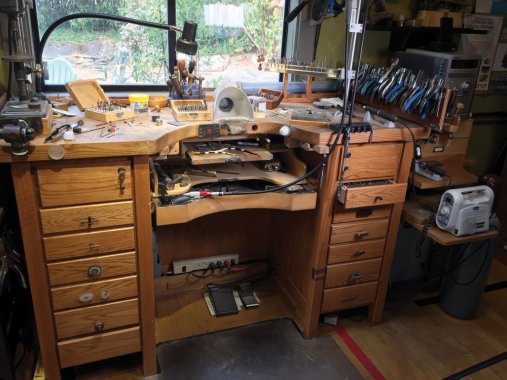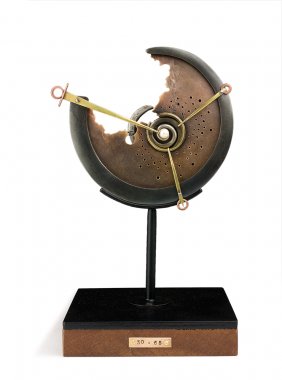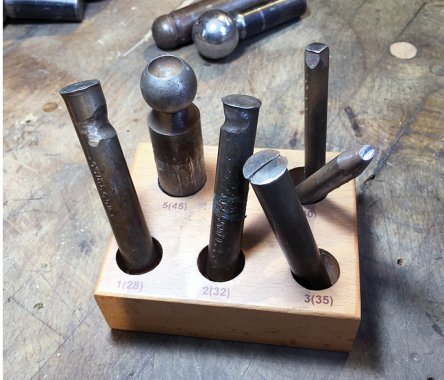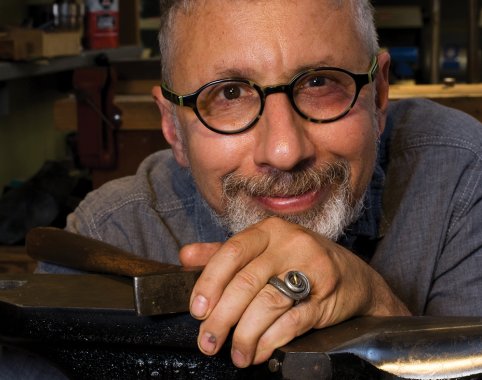Prisoners of Their Own Devices
Prisoners of Their Own Devices
A well-made tool is a transcendent object, its allure equal parts functional potential and elegance of form. Even if its purpose now seems obscure or irrelevant (a soldering blowpipe and an alcohol lamp come to mind), it still matters as a reminder of how things were and how things were done. It remains a compelling and often beautiful object.
It’s easy for a maker to stand in awe of a good tool. My tools are an extension of my body, allowing me to perform tasks more precisely or effectively than I can with my body alone. I can’t manifest an idea in physical form without tools. In the end, though, I know better than to revere a tool – because when an idea is screaming to be born, the fear of permanently altering a beloved tool, or facing its loss, can become an insurmountable hurdle. Tool reverence is dangerous for any maker.
That said, I understand the deference toward even humble tools. Hanging in my studio are pliers and hammers that I found at yard and estate sales. Small histories are soaked into their handles. These tools come from the benches of smiths I’ve never met; I’m not sure about their genders, their politics, their abilities, or their favorite foods, but I think about these makers every time I pick up one of these tools. And I know that, on one basic level, we would understand each other.
Tool use runs from simple to sublime. Sometimes we need a very basic tool to get a job done, and we’ll grab whatever is at hand (not necessarily the best practice). Other times, extending the use of a tool by reorienting or reapplying it – say, using a hammer’s handle instead of its head – can help get the job done.
But sometimes a tool needs to be seriously altered. In my studio, I seek a balance between my respectful use of a tool and the potential it offers. Let’s say that I have an idea for an object, and I have a tool in my studio that will allow me to bring it to life. But the tool must be altered, perhaps permanently, or even entirely consumed in the process. If it’s an ordinary, replaceable tool that I’m not attached to, I’ll consider changing it.
When I remodeled my studio several years ago, I treated myself to a new, grown-up jeweler’s bench. It was an expensive piece of furniture, made by a cabinetmaker and exponentially better than all those benches I had built myself over the years. But the top just didn’t have the specific scooped profile that worked for me. I desperately pined for that old curve, but I just couldn’t bring myself to violate this new beauty. I didn’t want to scratch or drill holes in it, let alone bring out the saber saw. Then, after a month of frustration, I finally cut deeply into the 2-inch-thick oak slab. As the severed oak dropped away, I felt barbaric and irresponsible. But it was the right thing to do.
It’s no wonder we collect tools. It’s no wonder that we coddle them, and no surprise that sometimes we end up worshiping them. And that’s where the trouble can begin. Sure, we should respect and care for our tools; they provide us with the ability to realize our ideas. They enrich our lives. But there is a difference between healthy respect for a tool and tool infatuation. And even though some tools hold a special place of power in our hearts, studios aren’t shrines; they’re not altars on which to worship tools. When tools are sacred icons, they can be barriers between ourselves and what we want to make. We are less likely to push a material – or ourselves – if we’re worried about damaging a tool. We can become tight and overly cautious and, worst of all, lose our sense of play. No matter how useful or lovely, a tool is just a means to an end.
Tool-users great and small
As special as our relationship with tools is, we are not the only species that uses them. Egyptian vultures break open thick-shelled ostrich eggs with stones. Otters pound open sea urchins against rocks held on their chests. Seagulls drop mussels on rocks to break them open. Chimps and some finches use sticks or cactus spines to fish out insects from hollow tree limbs. Dolphins have even been known to use scavenged sea sponges to cushion and protect their snouts when hunting in a rocky seabed.
Some animals even make tools. The male bowerbird, for example, builds beautiful and innovative arbor-like structures, or bowers, decorated with shells, feathers, bits of tin cans, paper, cellophane, or anything that catches his eye – designed to lure a lady bowerbird into a relationship. In building his bower, the male has been reported to create a kind of paint brush by fraying a twig against a rock before using it to apply berry juice to his construction. By adding a bright, enticing color to an already extravagant structure, the bird amps things up, communicating need and desire, maybe even pride, through ornamentation and embellishment.
And like the bowerbird, aren’t we makers also using tools to court others with our ideas, sharing our needs and points of view by making objects that aspire to bridge gaps and form relationships? We may be stating our case or venting emotion, stirring the pot or trying to change another’s perspective by sharing something beautiful or compelling. Beauty, creativity, love, communication, society, and culture, continuity of thought and even of species – all of these require tools.






